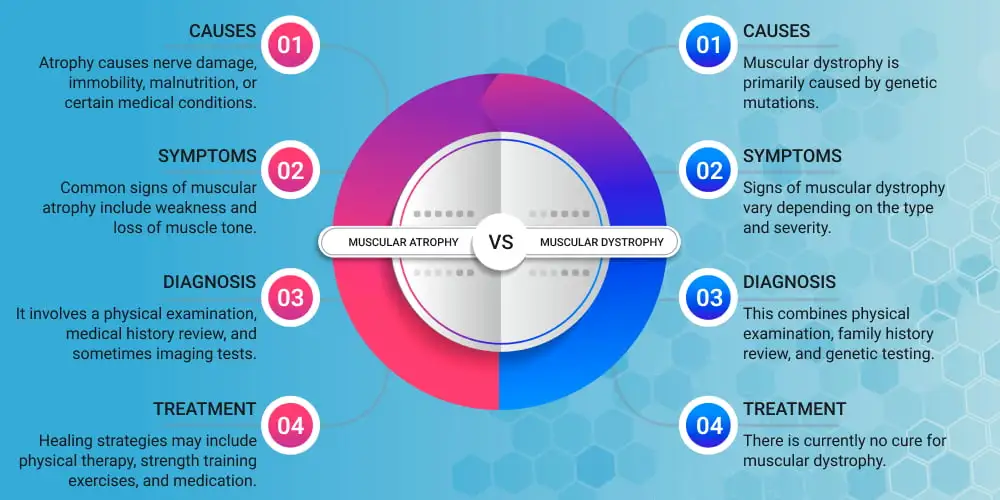In neuromuscular disorders, some terms are often used interchangeably. One of them is muscular atrophy vs. dystrophy. Yet they represent distinct conditions with different underlying mechanisms and clinical presentations. Our introduction aims to elucidate the fundamental disparities between them. It sheds light on their respective characteristics and implications for affected individuals. Muscular atrophy is the wasting or losing of muscle tissue. It typically results from disuse, denervation, or underlying medical conditions. Such illness manifests as decreased muscle mass and strength. It leads to weakness and functional impairment.
On the other hand, muscular dystrophy encompasses a group of genetic disorders. Characterized by progressive muscle weakness and degeneration. Unlike atrophy, dystrophy involves abnormalities in the structure or function of muscle proteins. It leads to muscle fiber damage and replacement by fat and connective tissue. Understanding the disparities between dystrophy vs. atrophy is crucial. It will help quickly recognize and treat the disease at an early stage.
Understanding Muscular Atrophy
This condition is progressive muscle mass and strength loss. It leads to weakness and functional impairment. It can occur due to various factors, including injury, disease, or lack of use. Here’s a brief overview:
- Causes: Atrophy causes nerve damage, immobility, malnutrition, or certain medical conditions. Among them are ALS (amyotrophic lateral sclerosis) or muscular dystrophy.
- Symptoms: Common signs of muscular atrophy include weakness and loss of muscle tone. Also, individuals may experience decreased mobility and muscle stiffness.
- Diagnosis: It involves a physical examination, medical history review, and sometimes imaging tests. Among them are MRI or CT scans to assess muscle size and condition.
- Treatment: Healing strategies may include physical therapy, strength training exercises, and medication. Also, they involve addressing underlying medical conditions contributing to the atrophy.
Knowing the causes, signs, diagnosis, and treatment options for muscular atrophy. They help with proper management and improving the quality of life for affected individuals.
Understanding Muscular Dystrophy
Such an illness is a group of genetic disorders. It is always characterized by progressive muscle weakness and degeneration. Here’s what you need to know about this condition:
- Types: There are several types of muscular dystrophy, each caused by a genetic mutation. Common types include Duchenne, Becker, myotonic, and facioscapulohumeral muscular dystrophy.
- Cause: Muscular dystrophy is primarily caused by genetic mutations. They interfere with producing proteins needed for healthy muscle function. These mutations result in muscle weakness and degeneration over time.
- Symptoms: Signs of muscular dystrophy vary depending on the type and severity. They include progressive muscle weakness, stiffness, difficulty walking, and eventual loss of mobility.
- Diagnosis: This combines physical examination, family history review, and genetic testing. Also, diagnosis consists of a muscle biopsy to confirm the presence of specific genetic mutations.
- Treatment: There is currently no cure for muscular dystrophy. Treatment focuses on managing signs and improving quality of life. It may include physical therapy, assistive devices, and medications. In some cases, cure plans involve gene therapy or clinical trials.
Understanding the genetic basis, signs, diagnosis, and treatment options. It helps in effectively managing the condition and providing appropriate support.
Dystrophy vs Atrophy: A Comparative Analysis
In muscular disorders, dystrophy vs. atrophy represents two distinct yet interconnected conditions. They have significant implications for muscle health and function. Let’s dissect the differences and similarities between these two phenomena. It sheds light on their etiology, manifestations, and management strategies.
Dystrophy
This condition encompasses a group of genetic disorders. They are generally characterized by progressive muscle weakness and degeneration. Muscular dystrophy presents significant challenges to affected individuals and their families.
Duchenne and myotonic dystrophy are among the various types. Each is always distinguished by its unique genetic mutation and clinical presentation. This condition not only impacts physical health. Also, it poses emotional and social challenges due to its chronic and debilitating nature.
Families and caregivers often face significant stress. It is inevitable when meeting the complex needs of people who have muscular dystrophy. It emphasizes the importance of comprehensive support systems and ongoing research efforts. They aim to promote treatment options and improve the quality of life of those affected.
Atrophy
This illness commonly stems from disease, injury, or neurological conditions. Such factors distinguish it from the primarily genetic nature of dystrophy. This condition can significantly impact muscle strength and mobility. It highlights the need for tailored interventions to mitigate or reverse its effects. It doesn’t matter whether it is caused by prolonged immobility, nerve damage, or other underlying factors.
Addressing muscle atrophy requires a multifaceted approach. It helps encompass physical therapy, targeted exercises, and nutritional support. Such an approach aids medical management to optimize muscle function and overall well-being. Recognizing the diverse etiologies and implications of muscle atrophy is crucial. It underscores the importance of personalized treatment strategies. They are vital for preserving and enhancing muscle health in affected individuals.
Spinal Muscular Dystrophy vs Atrophy
Spinal muscular dystrophy vs. muscle atrophy affects muscle health. Yet, they differ significantly in their underlying causes, progression, and management. Our exploration aims to dissect the distinctions between spinal muscular dystrophy and atrophy. It sheds light on their unique characteristics and implications for affected individuals. Such a condition represents a group of genetic disorders. They are generally characterized by progressive muscle weakness and degeneration. They primarily affect the muscles responsible for movement. Various subtypes, such as SMA type 1, SMA type 2, and SMA type 3, exhibit differing onset and severity. Spinal muscular dystrophy poses significant challenges to individuals and families.
Critical features of SMD:
- Genetic Basis: Spinal muscular dystrophy is primarily caused by genetic mutations. They affect the survival motor neuron (SMN1) gene.
- Progressive Muscle Weakness: Muscles progressively weaken over time. It leads to difficulties in mobility, breathing, and other motor functions.
- Symptoms: They include muscle weakness, hypotonia, and difficulty swallowing. Also, among common signs are respiratory issues and spinal curvature (scoliosis).
Conversely, muscle atrophy is the wasting or losing of muscle tissue. It typically results from disuse, injury, or neurological conditions. Unlike spinal muscular dystrophy, atrophy can arise from various causes beyond genetic predisposition. They include prolonged immobility or nerve damage.
Crucial features of muscle atrophy:
- Causes: This condition can result from lack of physical activity, immobilization (e.g., bed rest), and nerve damage. Also, malnutrition, aging, and certain medical conditions may cause it.
- Progression: Atrophy may occur rapidly or gradually. It depends on the underlying cause and severity.
- Symptoms: Muscle weakness, reduced muscle mass, and decreased mobility. Also, among common signs are potential complications such as contractures and joint stiffness.
Comparing spinal muscular dystrophy vs. muscle atrophy is pivotal. So, we bridge the understanding between these two conditions. Also, we elucidate their distinct etiology, clinical manifestations, and treatment approaches. Gaining a better understanding of these differences is essential for doctors and patients. This way, they can deal with their difficulties more clearly and effectively.
| Aspect | Spinal Muscular Dystrophy | Muscle Atrophy |
| Etiology | Genetic mutations affecting SMN1 gene. | Varied, including disuse, injury, or neurological causes. |
| Progression | Progressive muscle weakness over time. | It may occur rapidly or gradually, depending on the cause. |
| Symptoms | Muscle weakness, hypotonia, respiratory issues. | Muscle weakness, reduced muscle mass, decreased mobility. |
| Treatment | Supportive care, physical therapy, medication. | Addressing the underlying cause, physical therapy. |
Conclusion
You can now understand the distinctions between muscular atrophy vs. dystrophy with our help. They differ significantly in their underlying causes, progression, and clinical manifestations. Muscular atrophy results from disuse or neurological conditions. They are leading to muscle wasting and weakness. Dystrophy is primarily caused by genetic mutations affecting muscle structure and function. They result in progressive degeneration over time. Understanding these distinctions is crucial for accurate diagnosis and effective treatment planning. At Lone Star Neurology, you can significantly improve your quality of life. Our team helps to provide personalized care and treatment strategies to our patients.
FAQ
What is the main difference between muscular atrophy and dystrophy?
The main difference between muscular atrophy and dystrophy lies in their underlying causes. Among them is atrophy, which results from muscle disuse or damage. Dystrophy is primarily caused by genetic mutations affecting muscle structure and function.
Can muscular dystrophy lead to muscular atrophy?
Yes, muscular dystrophy can lead to muscular atrophy over time. It is due to the progressive degeneration and weakening of muscles associated with the condition.
How is spinal muscular atrophy different from spinal muscular dystrophy?
Spinal muscular atrophy primarily affects the motor neurons in the spinal cord. It leads to muscle weakness and atrophy. In contrast, spinal muscular dystrophy directly affects the muscle tissue. It results in progressive muscle degeneration and weakness.
What are the treatment options for muscular atrophy and dystrophy?
Treatment options for muscular atrophy and dystrophy involve a combination of physical therapy. It helps to maintain muscle function, medications to manage symptoms, and supportive care to improve quality of life.












Please, leave your review
Write a comment: